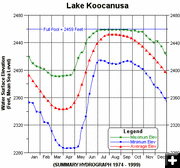

Historical Lake Fill
Historical Lake Koocanusa fill data. Graph courtesy U.S. Army Corps of Engineers.
|
|
Koocanusa fill forecast 86% of normal
Based on inflow data monitoring
March 13, 2005
Each winter, scientists with the US Army Corps of Engineers do their best to forecast the summer monthly fill rates for Lake Koocanusa Reservoir. These predictions for lake fill are based on a wide assortment of factors including current snow pack, long-term precipitation forecasts and melt rates over a very large watershed basin. The data is correlated to April through August normal inflow information from historical records for 1971 through 2000.
Inflow predictions steadily dropping
Inflow forecasts for summer 2005 have been steadily dropping from the 90 percentiles late last year to a prediction of 86% as of March, 2005. According to US Army Corps of Engineer Fishery Biologist Greg Hoffman, Biologist for the Kootenai River & Libby Dam, "86% of normal means that right now, based on snow pack, long term precipitation forecasting, and other factors, we will likely only have 86% of the normal inflow into the reservoir during April through August." Hoffman indicated that the prediction rate this winter has been a downward trend since November, 2004, "one of the driest winters on record around here."
The inflow prediction numbers change monthly and will be tracked and reported for April and May. Based on this early data, it is still not possible to predict when, or if, Lake Koocanusa reservoir will hit full pool this summer. "Until these numbers solidify, itís difficult for me, or anyone, to predict when/if weíll hit full pool. Itís just not that simple" said Hoffman. At this early stage, this data is intended to give people watching the reservoir levels an indication of predictions for the inflow into the reservoir. The data is still very preliminary and there are many variables that can change the outcome with spring melt in May and June.
River flows for sturgeon, as well as the baseline bull trout flows, are based on the final May forecast. Hoffman said there is the potential to limit a salmon drawdown to a certain elevation and timeframe based on the inflow data, but that is largely decided at a political level.
Will the lake fill this year?
Based on historical data collected since 1974, Lake Koocanusa typically reaches its lowest levels in March and April each year. Spring run-off from the vast Kootenai River watershed begins rapidly filling the lake again during May and June. The lake typically reaches its highest elevation by the end of July and stays steady through the end of August. Draw-downs begin again around the beginning of September. Typically the lake is at good levels by the time people want to have their 4th of July picnics.
Those monitoring the levels can go to the websites below for statistical data and watch the fill progress daily. Also, the folks at Koocanusa Marina are happy to answer questions about current conditions on the lake, 406-293-7474, koocanusaresort@kvis.net, www.koocanusaresort.com
Lake Koocanusa lake water surface levels are automatically monitored and data is collected and reported at midnight each day (see related link below for daily water level data collected by the U.S. Army Corps of Engineers). As of Saturday, March 12, the lake surface elevation was at 2412 feet, 47 feet below full pool. Full pool is 2459 feet.
Water shortages loom for Montana this summer
According to the Natural Resources Conservation Service (NRCS), February was the fifth month in a row with below average precipitation. Statewide mountain precipitation during February was 37% of average. Mountain precipitation in the Columbia River basin was 29% of average; Missouri was 33%; St. Mary/Milk was 36%; and Yellowstone was 56%.
"Because of the low snowpack, water users and water managers need to anticipate very low streamflows this spring and summer," said Roy Kaiser, NRCS water supply specialist. "Unless there are major increases in the spring and summer precipitation, there could be significant surface water shortages in all areas of Montana."
Montana snowpack less than half of normal
Snowpack in the Kootenai River drainage in Montana is only 47% of normal. Overall including Canada, the Kootenai River drainage is 72% of average. The snowpack that is currently on the ground is what would normally be expected on the first of January. According to Kaiser, this means we are about two months behind in snowpack levels with only four to six weeks remaining in the annual snowfall season in which to make up the deficit. To reach the normal snow water content maximum, mountain snowfall would need to be about 200 to 350% of average over the next four to six weeks. Montanaís snowpack maximum usually occurs during April.
Kootenai River spring flow projections
Kootenai River stream flows are currently projected to be 53-59% of average for April through July. Last year, Kootenai River flows were 93-102% of average for April-July.
Related Links:
Kootenai River Basin (US Army Corps of Engineers)
Daily Koocanusa Reservoir water level data
Koocanusa Summary Hydrograph 1974-1999 monthly average flow levels
Current Montana Snowpack Declining at Record Rates (NRCS news release March 4, 2005)
|
